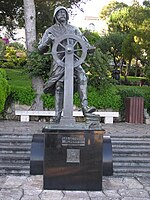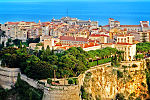Cathedral of Our Lady Immaculate

The Cathedral of Our Immaculate Lady (in French language: Cathédrale de Notre-Dame-Immaculée), formerly called the Cathedral of Saint Nicholas (demolished in 1874), or informally the Cathedral of Monaco (French: Cathédrale de Monaco), is the Roman Catholic national cathedral of the Archdiocese of Monaco in Monaco-Ville, Monaco, where many of the Grimaldi Royal members are buried, including former Grace, Princess of Monaco and Rainier III. The cathedral is dedicated to the Blessed Virgin Mary under the venerated title of the Immaculate Conception. It was built from 1875 to 1903 and consecrated on 11 June 1911. It is on the site of the first parish church in Monaco, built in 1252 and dedicated to its patron Saint Nicholas. Notable within the shrine are the retable (circa 1500) to the right of the transept, the High Altar and the Episcopal throne constructed in white Carrara marble. Pontifical services take place on the major religious festivals, such as the Feast of Sainte Dévote (27 January) and the National Day of Monaco (19 November). On feast days and during religious music concerts, one can hear the four-manual organ, inaugurated in 1976. From September through June, singers of the Cathedral Choir School perform during Catholic Mass every Sunday at 10:00 A.M. Services is also annually celebrated on Saint Nicholas Day on 6 December, when primary children gather for a remembrance of the life of Saint Nicholas.
Excerpt from the Wikipedia article Cathedral of Our Lady Immaculate (License: CC BY-SA 3.0, Authors, Images).Cathedral of Our Lady Immaculate
Rue de l'Abbaye, Monaco Monaco City
Geographical coordinates (GPS) Address Phone number Website External links Nearby Places Show on map
Geographical coordinates (GPS)
| Latitude | Longitude |
|---|---|
| N 43.730214 ° | E 7.422664 ° |
Address
Cathédrale Notre-Dame-Immaculée
Rue de l'Abbaye
98000 Monaco, Monaco City
Monaco
Open on Google Maps









